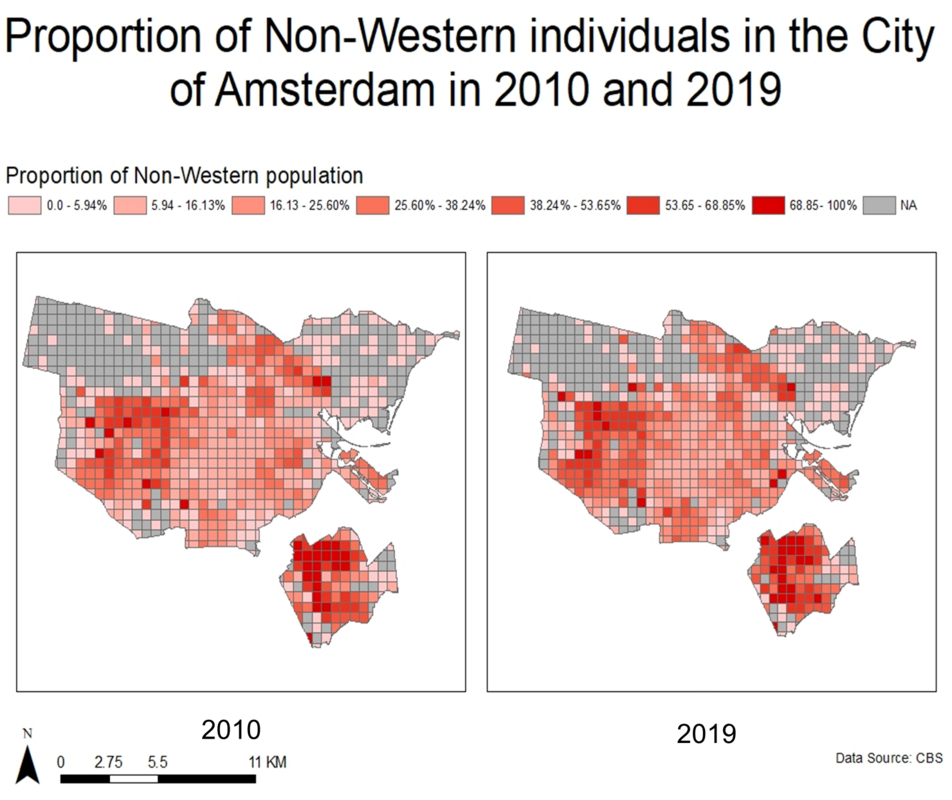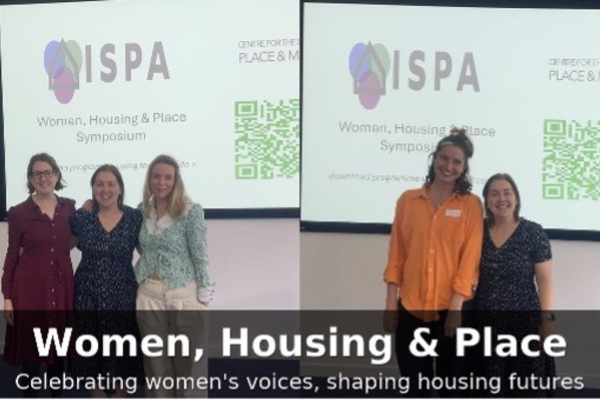
Figure 1: City of Amsterdam map (500x500m grid cells) showing the proportion of non-Westerners using data from Statistics Netherlands.
What happens when two contrasting communities border each other? We know that where we live can have a significant impact on our life experiences and opportunities, but there is a lack of research about what happens when we live near steep boundaries in terms of race, class, and income. Dean et al (2019) labelled these abrupt boundaries ‘social frontiers’, cliff edges in the social landscape that potentially impact mental health, crime rates (Dean et al., 2019; Křížková et al., 2021), and residential mobility (Olner et al., 2024).
Social frontiers are emerging as a potentially important form of residential segregation. Hence, I wanted to investigate whether they are becoming more prevalent, especially in the Netherlands, a country where, in 2022, nearly 15% of the population were born overseas (CBS, 2023). I have been focusing on social frontiers between non-Western migrants and Dutch-born residents in Amsterdam. 35% of Amsterdam residents had a ‘non-Western background’ in 2018 (CBS, 2019)[1], and areas of the city have large concentrations of non-Westerners (see Figure 1). We know from previous research that non-Western migrants are 17 times more likely to choose to live in a majority non-Western (80%+) neighbourhood compared to a neighbourhood where the majority of the residents were born in the Netherlands (Boschman and van Ham, 2015, p. 1165). The question is whether these neighbourhoods have gradual borders with adjacent communities, or whether there are large numbers of social frontiers which might indicate intergroup tension or territorial behaviour (Iyer and Pryce, 2024).
What is likely a crucial factor in housing location, and therefore the pattern of social frontiers in Amsterdam, is the relatively large social housing sector. Nearly 40% of housing stock was owned by housing associations in Amsterdam in 2023 (Onderzoek, Informatie en Statistiek (OIS), 2024). This is despite the stock decreasing by over 7% since 2013 (OIS, 2024). Hence, social housing determines the housing location of a large number of Dutch residents and especially non-Westeners. As in 2008 80% of immigrants originating from non-Western countries were living in areas which were majority social housing (Musterd and Fullaondo, 2008, p. 109).
Where are the Social Frontiers in Amsterdam?
In terms of social frontiers, we found three key patterns:
1. They mostly appear on the periphery of the Centrum (central) borough which has become increasingly gentrified, making it unaffordable for the majority of lower-income households. Therefore, as non-Western migrants earnt on average 34% less than the non-migrant residents in Amsterdam in 2013 (OECD, 2018) they are often forcibly displaced to the surrounding boroughs.
2. Social frontiers also exist within the Zuidoost exclave of the city - which is home to over 130 different nationalities. The borough includes the Bijlmermeer, a development from the 1960s which houses a large Surinamese population following their independence from the Netherlands in the 70s (Zahirović and Sterk, no date) and due to limited interest from the Dutch-born individuals based on lack of transport and dislike for the housing style.
3. An area which is surrounded by social frontiers is the Nieuw‐West borough (North West). The borough contains the Wildemanbuurt, a social housing area where over 5,000 people live. The area is infamous for high crime-rates and deprivation and mostly populated by individuals with a non-Western migrant background (Jeursen, 2021). It is perhaps unsurprising that the two areas which have a large non-Western population are the location of a large number of frontiers, and that the frontiers often occur where these areas border the centre.
Have social frontiers become more prevalent over time?
We developed an aggregate measure of social frontier prevalence that allows us to compare different cities and time periods. The first of these measures is the percentage of grid cell borders which are social frontiers. In our case the percentage of social frontiers between 2010 and 2019 decreased albeit only minimally (less than 1%) which we suspect would be unlikely to be felt in society. In 2019, 12% or approximately 1 in 8 borders in the city were social frontiers. However, some areas experienced far higher rates than others meaning the impact of social frontiers is unlikely to be consistent across the whole of the city.
We suspect that it is not just the prevalence of frontiers that matters but also their length. Longer frontiers may be more likely to restrict positive contact and have a greater symbolic meaning in nearby communities. We calculated a median length measure of social frontiers and found that it decreased between 2010 and 2019 from 1750m to 1500m (1500m is equal to 3 grid cell lengths in our data which uses 500mx500m grid cells). We also looked at the prevalence of single frontiers by measuring the percentage of the borders which are only the length of a single grid square. We found that the percentage of these singletons increased between 2010 and 2019. Single frontiers could occur because of random variation in the data or only be visible in a single year meaning that they are unsubstantial.
However, crucially we think their effect is likely to differ from longer frontiers with them having potentially a lesser impact on inter-group relations (Iyer and Pryce, 2024).
What can we conclude about the city of Amsterdam and social frontiers?
Overall, it seems that frontiers became slightly less prevalent between 2010 and 2019. This is remarkable given that over this period there was a significant rise in the non-Western population. It is possible that non-Western groups are becoming less segregated, with neighbourhoods becoming more diverse and social frontiers diminishing.
My plan is to dig deeper to understand these changes more fully, considering alternative methods of frontier magnitude: the duration, strength, and the percentage of the residents who live in close proximity to social frontiers. Along with “intersectional frontiers” where income and country of birth frontiers overlap. As well as considering whether policies in Amsterdam aimed at reducing segregation such as the Housing Act 2015, the rejuvenation of the Bijlmermeer, and schemes such as Starkblok - a housing project which aims to help young refugees integrate with young Dutch citizens - have impacted on the social frontier level. By developing a richer set of frontier measurements, I hope to provide future researchers with the data they need to understand what ultimately is the impact of contrasting communities living in close proximity to each other.
[1] Non-Western is a classification used by Statistics Netherlands to describe the country of birth of residents. An individual is defined as non-Western if they originate from Africa, South America, Asia (excluding Indonesia and Japan) and Turkey.
All analysis and results in this paper are based on calculations using non-public microdata from Statistics Netherlands. This blog is based on the findings from the first paper in my PhD thesis.
Author bio: Eleanor is currently completing a ESRC funded PhD focusing on Social Frontiers. The PhD is jointly supervised between the University of Sheffield and Delft University in the Netherlands.
References
Boschman, S. and van Ham, M. (2015) ‘Neighbourhood selection of non-Western ethnic minorities: testing the own-group effects hypothesis using a conditional logit model’, Environment and Planning A, 47(5), pp. 1155-1174. doi: https://doi.org/10.1177/0308518X15592300
CBS (2019) Population. Available at: https://www.cbs.nl/en-gb/background/2018/47/population (Accessed: 22 April 2024)
CBS (2023) How many residents have a foreign country of origin?. Available at:
https://www.cbs.nl/en-gb/dossier/asylum-migration-and-integration/how-many-residents-have-a-foreign-country-of-origin- (Accessed: 22 April 2024).
Dean, N. et al. (2019) ‘Frontiers in residential segregation: understanding neighbourhood boundaries and their impacts’, Tijdschrift voor economische en sociale geografie, 110(3), pp. 271-288. doi: https://doi.org/10.1111/tesg.12316
Iyer, A. and Pryce, G. (2024) ‘Theorising the causal impacts of social frontiers: The social and psychological implications of discontinuities in the geography of residential mix’, Urban Studies, 61(5), pp. 782-798. doi: https://doi.org/10.1177/00420980231194834
Jeursen, T. (2021) ‘Policing Amsterdam’s “Underworld”’, City & Society, 33(1). doi: https://doi.org/10.1111/ciso.12365
Křížková, I. et al. (2021) ‘Social Frontiers: Estimating the Spatial Boundaries Between Residential Groups and Their Impacts on Crime’, in Pryce, G. et al. (eds.) Urban Inequality and Segregation in Europe and China. Cham: Springer, pp. 285 304.
Musterd, S. and Fullaondo, A. (2008) ‘Ethnic Segregation and the Housing Market in Two Cities in Northern and Southern Europe: The Cases of Amsterdam and Barcelona’, Architecture, 8(8), pp. 94-115. doi: https://doi.org/10.5821/ace.v3i8.2459
OECD (2018) Working Together for Local Integration of Migrants and Refugees in Amsterdam, Paris: OECD Publishing. doi: https://doi.org/10.1787/9789264299726-en
Olner, D. et al. (2024) ‘The conflicting geographies of social frontiers: Exploring the asymmetric impacts of social frontiers on household mobility in Rotterdam’, Environment and Planning B: Urban Analytics and City Science, 51(3), pp. 625-640. doi: https://doi.org/10.1177/23998083231173696
Onderzoek, Informatie en Statistiek (OIS) (2024) ‘Property: % Housing corporation’. Available at: https://onderzoek.amsterdam.nl/interactief/dashboard-kerncijfers?tab=indicator&thema=wonen&indicator=WCORHUUR_P&indeling=ggwgebieden&jaar=2023&gebied=GA01&taal=en (Accessed: 7 May 2024).
Zahirović, S. and Sterk, B. (no date) ‘The Bijlmer: a Dutch Approach to Multiculturalism’, Humanity in Action. Available at: https://humanityinaction.org/knowledge_detail/the-bijlmer-a-dutch-approach-to multiculturalism/ (Accessed: 10 Jan 2023).
Eleanor Bale is a PhD student at the University of Sheffield as part of the Centre of Doctoral Training (CDT). Her studies focus on the impact of migration on segregation and the effect of social frontiers on social and economic factors such as educational outcomes, mental health, and crime. Eleanor works alongside researchers at Delft University using an incredible micro-level social science dataset containing detailed information about every Dutch citizen since 1999.







